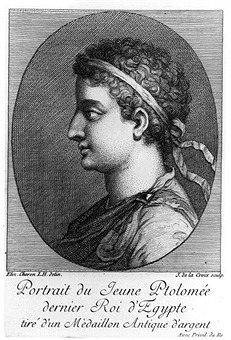Ptolemy XIII Theos Philopator facts for kids
Quick facts for kids Ptolemy XIII Theos Philopator |
|
|---|---|
| Πτολεμαίος ΙΓ΄ Θεός Φιλοπάτωρ | |

An engraving by Élisabeth Sophie Chéron, published c. 1736, based on a 1st-century BC medallion.
|
|
| King of the Ptolemaic Kingdom | |
| Reign | 51–47 BC with Cleopatra VII and Arsinoe IV (Ptolemaic) |
| Predecessor | Ptolemy XII Auletes |
| Successor | Ptolemy XIV Philopator |
| Consort | Cleopatra VII |
| Father | Ptolemy XII Auletes |
| Born | c. 62 BC |
| Died | prob. 13 January 47 BC (aged 14) Nile river |
Ptolemy XIII Theos Philopator (which means "Ptolemy, God Who Loves His Father" in Greek) was a young Pharaoh of Ancient Egypt. He ruled from 51 BC to 47 BC. Ptolemy XIII was one of the last kings from the Ptolemaic dynasty, a family that ruled Egypt for a long time. He was the son of Ptolemy XII and ruled alongside his older sister, Cleopatra VII. Their shared rule led to a civil war in Egypt. Later, he also ruled with his other sister, Arsinoe IV.
Contents
Ptolemy XIII's Life Story
Becoming a Co-Ruler
Ptolemy XIII became pharaoh in the spring of 51 BC when he was about 11 years old. His father, Ptolemy XII, had decided that Ptolemy XIII should marry his older sister Cleopatra VII and that they would rule Egypt together.
By October 50 BC, Ptolemy XIII was made the main ruler alongside Cleopatra. However, a powerful official named Pothinus acted as his guardian and advisor, making many decisions for him.
In the spring of 48 BC, Ptolemy XIII and Pothinus tried to remove Cleopatra from power. Cleopatra's image was appearing on coins, and her name was often used on important documents, while Ptolemy's name was sometimes left out. Ptolemy wanted to be the only ruler, with Pothinus guiding him from behind the scenes.
The Civil War Begins
Ptolemy XIII and Pothinus managed to make Cleopatra leave Egypt and go to Syria. But Cleopatra quickly gathered her own army, and a civil war started in Egypt. To make things even more complicated, their other sister, Arsinoe IV, also claimed the throne.
At this time, a famous Roman general named Pompey the Great came to Egypt. He was looking for safety because his rival, Julius Caesar, was chasing him. Ptolemy XIII first pretended to welcome Pompey. But on September 29, 48 BC, Ptolemy had Pompey killed by his officers, Achillas and Lucius Septimius. He hoped this act would make Julius Caesar happy when he arrived.
However, when Caesar arrived and was shown Pompey's head, he was not pleased. Instead, Caesar was upset and ordered that Pompey's body be found and given a proper Roman funeral. Cleopatra VII was much better at winning Caesar's favor and became his close ally. Caesar then arranged for Pothinus to be executed. He also officially returned Cleopatra VII to the throne, even though she had never truly given up her position.
Still wanting to remove Cleopatra VII from power, Ptolemy XIII formed an alliance with Arsinoe IV. Together, they gathered the parts of the army loyal to them. They fought against Cleopatra VII's forces and the small Roman army that had come with Caesar. A big battle happened in mid-December 48 BC right inside the city of Alexandria. The city was badly damaged during this fight, known as the Siege of Alexandria (47 BC). Around this time, the famous Library of Alexandria was also damaged by fire.
When more Roman soldiers arrived, the Battle of the Nile (47 BC) took place. Caesar and Cleopatra won this battle, forcing Ptolemy XIII to escape from the city. Reports say that he drowned on January 13, 47 BC, while trying to cross the Nile river. It's not clear if he was trying to run away or if he was trying to negotiate. After Ptolemy's death, Cleopatra VII became the undisputed ruler of Egypt. She named her younger brother, Ptolemy XIV, as her new co-ruler.
Ptolemy XIII in Pop Culture
Ptolemy XIII has appeared in several stories and films:
- He is a character in George Frideric Handel's 1724 opera Giulio Cesare in Egitto (which means "Julius Caesar in Egypt").
- He also appears in George Bernard Shaw's play Caesar and Cleopatra.
- In the 1963 movie Cleopatra, Ptolemy was played by Richard O'Sullivan.
- His conflict with Caesar and Cleopatra is shown in the HBO TV series Rome, in the episode called "Caesarion".
- The 2017 video game Assassin's Creed Origins also features Ptolemy's civil war with Cleopatra. In the game, he is shown as a young king controlled by a group called the Order of Ancients. They push him to remove his sister from power. He is shown as a weak young man whose alliance with Julius Caesar breaks as soon as Caesar meets Cleopatra. After Caesar wins the Battle of the Nile (47 BC), Ptolemy tries to escape in a boat. The boat is attacked by crocodiles, and the young pharaoh drowns.
Images for kids
-
Cleopatra VII, Ptolemy XIII's sister-wife
See also
 In Spanish: Ptolomeo XIII para niños
In Spanish: Ptolomeo XIII para niños



